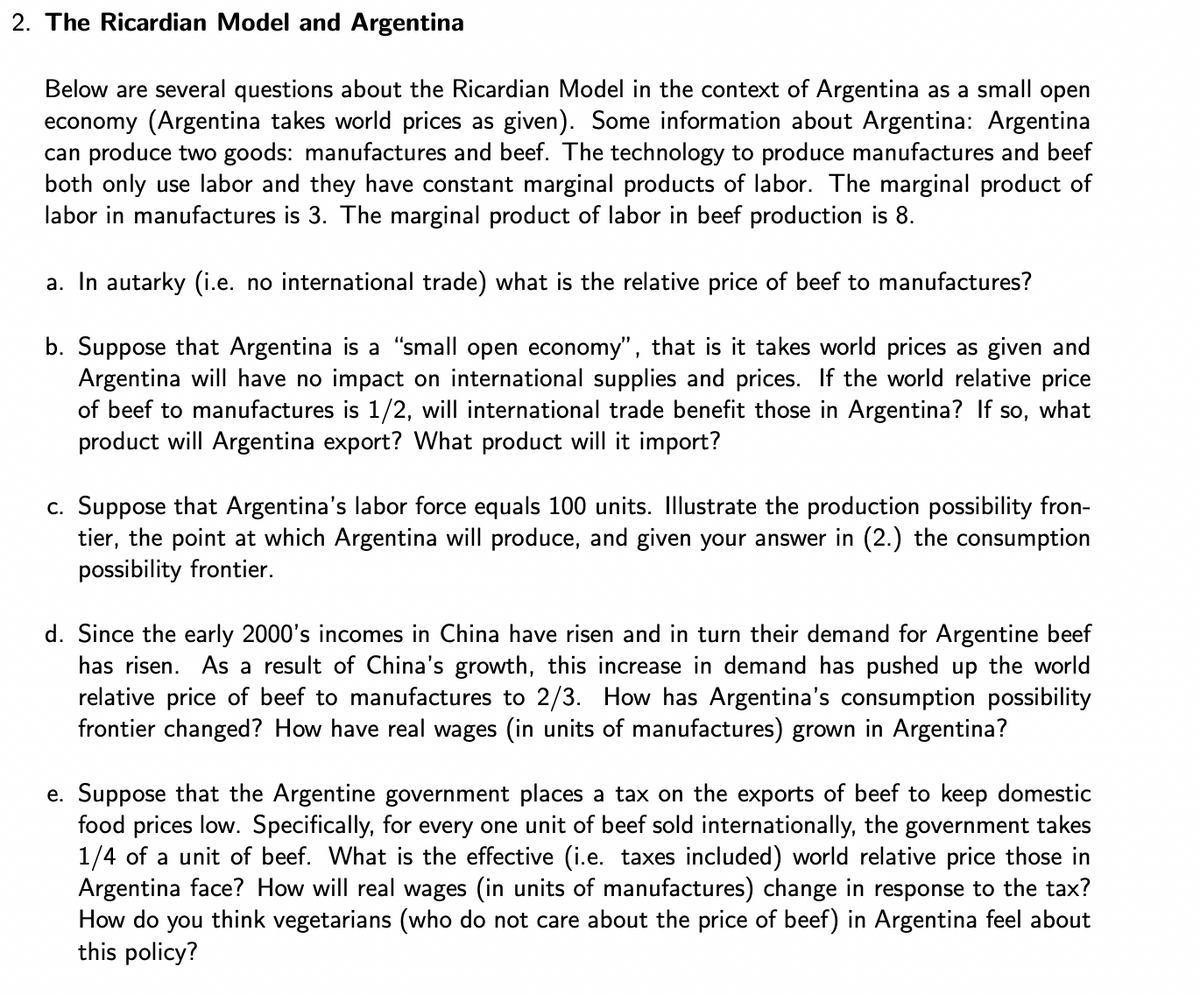e. Suppose that the Argentine government places a tax on the exports of beef to keep domestic food prices low. Specifically, for every one unit of beef sold internationally, the government takes 1/4 of a unit of beef. What is the effective (i.e. taxes included) world relative price those in Argentina face? How will real wages (in units of manufactures) change in response to the tax? How do you think vegetarians (who do not care about the price of beef) in Argentina feel about this policy?
e. Suppose that the Argentine government places a tax on the exports of beef to keep domestic food prices low. Specifically, for every one unit of beef sold internationally, the government takes 1/4 of a unit of beef. What is the effective (i.e. taxes included) world relative price those in Argentina face? How will real wages (in units of manufactures) change in response to the tax? How do you think vegetarians (who do not care about the price of beef) in Argentina feel about this policy?
Principles of Economics 2e
2nd Edition
ISBN:9781947172364
Author:Steven A. Greenlaw; David Shapiro
Publisher:Steven A. Greenlaw; David Shapiro
Chapter32: Macroeconomic Policy Around The World
Section: Chapter Questions
Problem 27CTQ: Explain what will happen in a nation that tries to solve a structural unemployment problem using...
Related questions
Question
Please do only the last one (and please not that beef profuction = 8 as it says in the problem)

Transcribed Image Text:2. The Ricardian Model and Argentina
Below are several questions about the Ricardian Model in the context of Argentina as a small open
economy (Argentina takes world prices as given). Some information about Argentina: Argentina
can produce two goods: manufactures and beef. The technology to produce manufactures and beef
both only use labor and they have constant marginal products of labor. The marginal product of
labor in manufactures is 3. The marginal product of labor in beef production is 8.
a. In autarky (i.e. no international trade) what is the relative price of beef to manufactures?
b. Suppose that Argentina is a "small open economy", that is it takes world prices as given and
Argentina will have no impact on international supplies and prices. If the world relative price
of beef to manufactures is 1/2, will international trade benefit those in Argentina? If so, what
product will Argentina export? What product will it import?
c. Suppose that Argentina's labor force equals 100 units. Illustrate the production possibility fron-
tier, the point at which Argentina will produce, and given your answer in (2.) the consumption
possibility frontier.
d. Since the early 2000's incomes in China have risen and in turn their demand for Argentine beef
has risen. As a result of China's growth, this increase in demand has pushed up the world
relative price of beef to manufactures to 2/3. How has Argentina's consumption possibility
frontier changed? How have real wages (in units of manufactures) grown in Argentina?
e. Suppose that the Argentine government places a tax on the exports of beef to keep domestic
food prices low. Specifically, for every one unit of beef sold internationally, the government takes
1/4 of a unit of beef. What is the effective (i.e. taxes included) world relative price those in
Argentina face? How will real wages (in units of manufactures) change in response to the tax?
How do you think vegetarians (who do not care about the price of beef) in Argentina feel about
this policy?
Expert Solution
This question has been solved!
Explore an expertly crafted, step-by-step solution for a thorough understanding of key concepts.
This is a popular solution!
Trending now
This is a popular solution!
Step by step
Solved in 2 steps

Knowledge Booster
Learn more about
Need a deep-dive on the concept behind this application? Look no further. Learn more about this topic, economics and related others by exploring similar questions and additional content below.Recommended textbooks for you

Principles of Economics 2e
Economics
ISBN:
9781947172364
Author:
Steven A. Greenlaw; David Shapiro
Publisher:
OpenStax

Brief Principles of Macroeconomics (MindTap Cours…
Economics
ISBN:
9781337091985
Author:
N. Gregory Mankiw
Publisher:
Cengage Learning

Principles of Economics 2e
Economics
ISBN:
9781947172364
Author:
Steven A. Greenlaw; David Shapiro
Publisher:
OpenStax

Brief Principles of Macroeconomics (MindTap Cours…
Economics
ISBN:
9781337091985
Author:
N. Gregory Mankiw
Publisher:
Cengage Learning